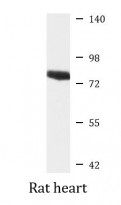ARG41106
anti-TGM5 antibody
anti-TGM5 antibody for IHC-Formalin-fixed paraffin-embedded sections,Western blot and Human,Mouse,Rat
Overview
| Product Description | Rabbit Polyclonal antibody recognizes TGM5 |
|---|---|
| Tested Reactivity | Hu, Ms, Rat |
| Tested Application | IHC-P, WB |
| Host | Rabbit |
| Clonality | Polyclonal |
| Isotype | IgG |
| Target Name | TGM5 |
| Antigen Species | Human |
| Immunogen | Recombinant fusion protein corresponding to aa. 461-720 of Human TGM5 (NP_963925.2). |
| Conjugation | Un-conjugated |
| Alternate Names | Transglutaminase-5; TGM6; TGMX; TGase-5; TGX; TGase X; Protein-glutamine gamma-glutamyltransferase 5; X; TGASE5; PSS2; TG; TGASEX; EC 2.3.2.13; Transglutaminase X |
Application Instructions
| Application Suggestion |
|
||||||
|---|---|---|---|---|---|---|---|
| Application Note | * The dilutions indicate recommended starting dilutions and the optimal dilutions or concentrations should be determined by the scientist. | ||||||
| Positive Control | Rat heart | ||||||
| Observed Size | 81 kDa |
Properties
| Form | Liquid |
|---|---|
| Purification | Affinity purified. |
| Buffer | PBS (pH 7.3), 0.02% Sodium azide and 50% Glycerol. |
| Preservative | 0.02% Sodium azide |
| Stabilizer | 50% Glycerol |
| Storage Instruction | For continuous use, store undiluted antibody at 2-8°C for up to a week. For long-term storage, aliquot and store at -20°C. Storage in frost free freezers is not recommended. Avoid repeated freeze/thaw cycles. Suggest spin the vial prior to opening. The antibody solution should be gently mixed before use. |
| Note | For laboratory research only, not for drug, diagnostic or other use. |
Bioinformation
| Database Links |
Swiss-port # O43548 Human Protein-glutamine gamma-glutamyltransferase 5 Swiss-port # Q9D7I9 Mouse Protein-glutamine gamma-glutamyltransferase 5 |
|---|---|
| Gene Symbol | TGM5 |
| Gene Full Name | transglutaminase 5 |
| Background | This gene encodes a member of the transglutaminase family. The encoded protein catalyzes formation of protein cross-links between glutamine and lysine residues, often resulting in stabilization of protein assemblies. This reaction is calcium dependent. Mutations in this gene have been associated with acral peeling skin syndrome. [provided by RefSeq, Oct 2009] |
| Function | Catalyzes the cross-linking of proteins and the conjugation of polyamines to proteins. Contributes to the formation of the cornified cell envelope of keratinocytes. [UniProt] |
| Cellular Localization | Cytoplasm. Note=Associated with intermediate filaments. [UniProt] |
| Calculated MW | 81 kDa |
Images (2) Click the Picture to Zoom In







